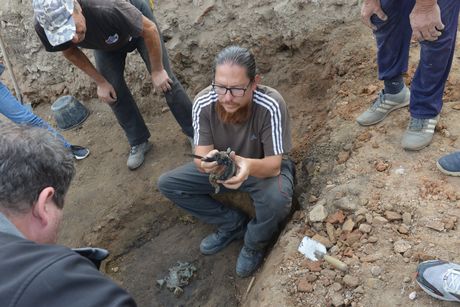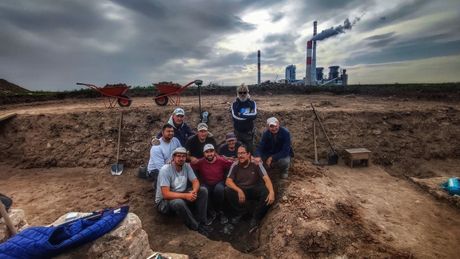Viminacium tintinnabulum is unique in the world: Dr. Dankovic tells Telegraf Nauka about sensational discovery

Archaeologists working at the Viminacium site, eastern Serbia, have made a sensational discovery - they dug up a tintinnabulum or a "home guardian" in the shape of a winged phallus, which served as protection against evil forces and the evil eye. Very few such objects were found in the area of the former Roman Empire, which makes the success of Serbian archaeologists, that has been reported by all important global scientific portals, particularly great.
Dr. Ilija Dankovic, a research associate with the Archaeological Institute in Belgrade, explained for Telegraf Nauka (Telegraf Science) how they achieved the discovery, what they currently know about this unusual object, as well as the importance of Viminacium in general.
2nd century Tintinabulum
"At the beginning of August, the team from the Archaeological Institute (Serbian; Arheoloski Institut) started excavations in the urban core of Viminacium. That was the first excavation focused on residential areas (of the ancient Roman stronghold) in half a century. In the meantime, monumental buildings of public character - baths and an amphitheater - were explored inside the city. The initial phase of excavation was focused on the main city street (Latin: decumanus), as well as on the complex system of sewage canals in this area. After that, the buildings that line up the street started to be explored. The discovery of the Viminacium tintinnabulum took place in a porch of one of these buildings," said Dr. Dankovic. and added:
"Very soon after locating the object and starting to clean it, we noticed the legs, wings and tail in the shape of a phallus, so it became clear that it was a tintinnabulum. Going by analogies, but also by other items discovered in this layer, we can say, preliminarily, that our specimen was used during the second half of the 2nd century AD."
Dr. Ilija Dankovic says that the significance of the tintinnabulum from Viminacium is manifold.

Discoveries with greatest resonanceAsked what are considered the biggest discoveries in Viminacium in recent years, Dr. Ilija Dankovic says: "If we had to single out the discoveries that had the most resonance in the public, but also within the scientific community, they would certainly be: the magic tiles made of gold and silver, a sarcophagus, that had not been looted, containing the remains of a married couple, wooden vessels dating 1,700 years back, a collection of 7 gold coins from the time of the destruction of the city by the Huns, lead sarcophages, the principium (the commander's HQ) in the legionnaire camp...
"It is certainly a type of object that is quite rare, and outside of Pompeii and Herculaneum, something like it has been discovered extremely rarely during proper archaeological excavations. Furthermore, preliminary conservation and X-rays have shown that this specimen has some elements that will make it unique in the corpus of tintinnabulums found throughout the Empire. From a scientific point of view, it tells us about the fears, tastes and habits of the inhabitants of Viminacium, and specifically of the family that lived in the household we are investigating. It is clear that, although they lived on the outskirts of the Roman World, they were a part of that civilization and they inherited the cultural traditions of the Mediterranean area," he explained.
Collaboration with Harvard and DNA analysis
Viminacium is one of the most important archaeological sites in Serbia. It was first a Roman military outpost, and then became a city, which was for a time also the capital of the province of Upper Moesia (Moesia Superior, roughly corresponding to modern-day Serbia).

"The exploration in Viminacium is carried out during most of the year, and takes place on two fronts: protective, due to the proximity of a (modern) power plant and a coal strip mine, and systematic, which in the past seasons was focused on the legionnaire camp, and from there also on the city. All these excavations are constantly enriching our knowledge about the appearance and functioning of fortifications and civilian settlements, about the infrastructure of the suburban and rural parts of Viminacium, and through mobile archaeological material about the worldviews, beliefs and customs at these locals in ancient times," says Dr. Dankovic.
When asked how research methods have changed with the development of new technologies, he replies:
"Today, archeology is unimaginable without a multidisciplinary approach, so soil tests are performed using various geophysical methods before excavation, while the objects we find are subjected to many analyses. A team of conservators is part of the overall team and they adopt and develop a methodology to protect the artifacts. This summer, cooperation with experts from Harvard University was also established, which involves examination of ancient DNA belonging to almost a thousand individuals whose remains were discovered during the exploration of a necropolis, which will bring a completely new dimension to the study of the local population."
(Telegraf Nauka)
Video: Novinar Telegrafa "svat" na grčkoj svadbi: Oficiri nevestu svog kolege dočekali zveketom mačeva
Telegraf.rs zadržava sva prava nad sadržajem. Za preuzimanje sadržaja pogledajte uputstva na stranici Uslovi korišćenja.

